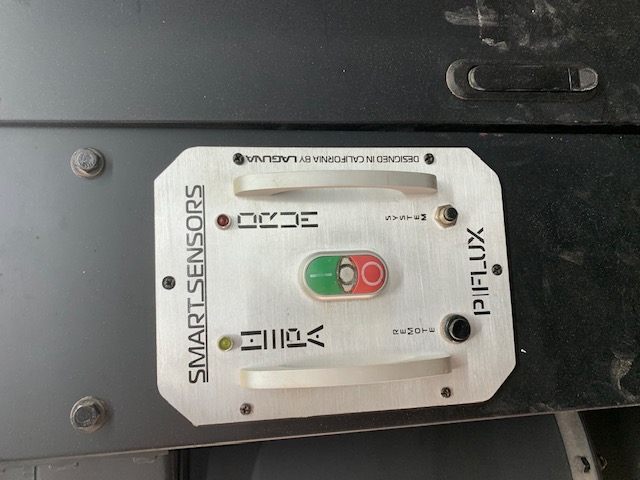Juss1, here are some photos of my D/C closet with a little explanation:
1. my workshop is tiny (17' X 27'), so didn't have room to build a large closet around my cyclone. Mine is just large enough to house the cyclone. I put peg board on the outside after sheeting the outside walls with Homasote to give me a place to hang router bits and other stuff. Here is the outside view:
![[Image: 51947220207_25ed3d2651_k.jpg]](https://live.staticflickr.com/65535/51947220207_25ed3d2651_k.jpg) 0D352344-A9B9-412C-B35C-DDD5893CA492
0D352344-A9B9-412C-B35C-DDD5893CA492 by
Hank Knight, on Flickr
The door is divided in half like a French door to give me access to the dust bin without having to open the whole thing. The doors are made of a 2X4 frame with Homasote sheeting, insulated with closed cell foam insulation between the sheets and hung with heavy piano hinges. At the top above the door in the photo is one of the baffled exhaust vents. The outside opening opening is 4" X the width of the door. It has Homasote sheeting on both sides of the 2X4 frame. The space between the sheets has a Homasote sound baffle that runs down the middle of the space. The baffle runs all the way from the top of the opening and stops 5" short of the bottom. Exhaust air must make a U turn, starting at the top of the inside duct, running down to the bottom of the baffle where it makes a 180º turn up the other side and out the top vent on the outside of the wall into the shop. The baffle reflects and absorbs sound waves before they get to the outside. How this works is a subject too long for this post, but some online research into sound baffles will provide several good articles on the subject with diagrams that helped me design my baffles. My closet has baffled vents around the top three sides. They provide enough air flow capacity for my cyclone without restricting its suck.
Here is a photo of the exhaust vent above the door:
![[Image: 51947222542_0ab9e6c30b_k.jpg]](https://live.staticflickr.com/65535/51947222542_0ab9e6c30b_k.jpg) 87B3B8BD-38A5-4D35-8063-1059950EC9B7
87B3B8BD-38A5-4D35-8063-1059950EC9B7 by
Hank Knight, on Flickr
Here is the interior with the door completely open. As you can see, it's a pretty small closet:
![[Image: 51947223702_3b42ad3353_k.jpg]](https://live.staticflickr.com/65535/51947223702_3b42ad3353_k.jpg) 8B4E4AC8-F105-4F6E-84B9-CFF20B8175DB
8B4E4AC8-F105-4F6E-84B9-CFF20B8175DB by
Hank Knight, on Flickr
I stapled 1/2" hardware cloth to the inside of he 2X4 frame to give the fiberglass insulation some backing. The insulation went against the hardware cloth and the exerior Homasote sheeting went on. I bradded on some 1/2" firring strips to the outside and bradded the peg board to that to finish it off. Here is the inside view of he hardware cloth and the pink fiberglass insulation. The clear palstic box-looking structure at the top of the photo is the cyclone's intake duct.
![[Image: 51948279773_70949cbeb4_k.jpg]](https://live.staticflickr.com/65535/51948279773_70949cbeb4_k.jpg) 4A531C5E-5A15-433F-8876-FB844884AE89
4A531C5E-5A15-433F-8876-FB844884AE89 by
Hank Knight, on Flickr
This photo shows the top inside walls of the closet with the interior exhaust ducts at the very top. By the way, don't forget to insulate the ceiling of the closet, and you need to seal any and all cracks in your structure that would allow pesky sound waves to escape. I sealed my door with foam tape and stuffed fiberglass in any other open cracks and crevices I found.
![[Image: 51947226387_e3be8848c4_k.jpg]](https://live.staticflickr.com/65535/51947226387_e3be8848c4_k.jpg) D1D6B7D2-3042-4829-93A3-F326EA99FC23
D1D6B7D2-3042-4829-93A3-F326EA99FC23 by
Hank Knight, on Flickr
You asked about the best size for the main ductwork. It depends on your D/C unit. The rule is bigger= better, but your D/C must move enough air to keep the pressure high enough to be effective. My main ducts are 6" in diameter with 4" drops to most of my machines. I have a 6" drop to my radial arm saw and to my lathe, but all the rest are 4" drops. Here is a photo of the outside of my closet with the main intake duct:
![[Image: 51948217111_d9e2489943_k.jpg]](https://live.staticflickr.com/65535/51948217111_d9e2489943_k.jpg) 75FDE2CF-970A-4E93-9B31-8D1224C8FCC6
75FDE2CF-970A-4E93-9B31-8D1224C8FCC6 by
Hank Knight, on Flickr
My 6" duct branches about 4' after it exits the closet and runs down both sides of my shop with 4" drops as needed aloing the way. Run the large duct as close to your machines as is practical before reducing it. You want the air flow as open as possible as long as possible to move as much air as possible. The smaller the duct, the more it restricts the air flow. You probably should check the owner's manual for your D/C for the recommended duct size. I notice that your machine has multiple 4" outlets. That probably means it moves enough CFM to handle a 6"main duct. You'll need some kind of adaper in place of the 3 X 4" turret you currently have on the machine.
I'm sure this is more than you wanted to hear and know about my D/C closet, but I hope it helps and gives you some ideas.













![[Image: 51947220207_25ed3d2651_k.jpg]](https://live.staticflickr.com/65535/51947220207_25ed3d2651_k.jpg)
![[Image: 51947222542_0ab9e6c30b_k.jpg]](https://live.staticflickr.com/65535/51947222542_0ab9e6c30b_k.jpg)
![[Image: 51947223702_3b42ad3353_k.jpg]](https://live.staticflickr.com/65535/51947223702_3b42ad3353_k.jpg)
![[Image: 51948279773_70949cbeb4_k.jpg]](https://live.staticflickr.com/65535/51948279773_70949cbeb4_k.jpg)
![[Image: 51947226387_e3be8848c4_k.jpg]](https://live.staticflickr.com/65535/51947226387_e3be8848c4_k.jpg)
![[Image: 51948217111_d9e2489943_k.jpg]](https://live.staticflickr.com/65535/51948217111_d9e2489943_k.jpg)